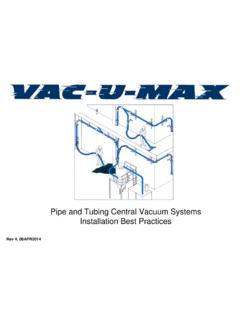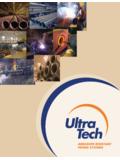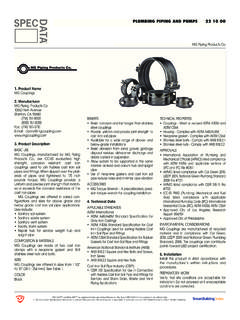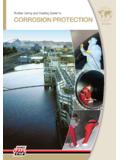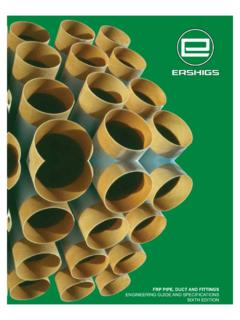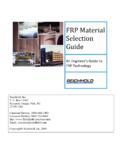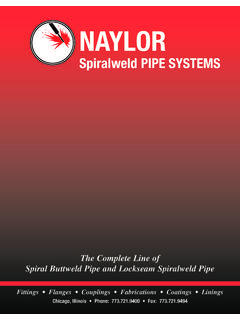Transcription of Pipe and Tubing Central Vacuum Systems …
1 Pipe and Tubing Central Vacuum SystemsInstallation best PracticesRev 4, 08 APR2014 Welcome!The world of industrial Vacuum cleaning Systems is as varied as the number of different businesses in our marketplace. There is no universal design, no jack-of-all-trades, no Swiss Army Knife that will suit all facilities. There are certain elements of physical science that can and must be evaluated for any Central Vacuum system such as pick-up velocity, line losses, altitude, moisture content, abrasion, etc. However, when all of the science is done, the system will not be complete without the art of the Central Vacuum network design. There are so many idle Central Vacuum Systems that relied too much on science, too much on standard thinking, and not enough art . The VAC-U-MAX art is 60 years of experience in powder and debris handling all over the encourage your questions and comments after reviewing this document, and we look forward to working with you on your Central Vacuum system Specifications Acceptable Tubing Materials: carbon steel, galvanized steel, aluminum or stainless steel Tubing or iron/steel pipe.
2 Plastic pipe materials are NOTacceptable Nominal Network Material Sizes (Tube is sized by OD, Pipe is sized by ID) (50mm), 2-1/8 (54mm) (not available in pipe size), (63mm), (75mm), (100mm), (125mm), and (150mm)In most housekeeping applications with or 2 hose sizes, all vertical pipes from horizontal headers are 2 (tube or pipe) or 2-1/8 (tube only) size, with the latter size being more common in the industrial Vacuum cleaning industry. Large spill pickup locations may have larger inlet valves. In some industries, tubingis not utilized, and in other industries, some pipesizes are uncommon and therefore not frequently NOT COMBINE PIPE MATERIALS AND TUBE MATERIALS IN THE SAME NETWORK BECAUSE THE AND DO NOT MATCH UP. Wall Thickness: Tubing : 16-gauge ( ) is common for non-abrasive materials. A network for mildly-abrasive** debris should use 11-gauge ( ) : schedule 40 is recommended.
3 Other wall thicknesses such as schedule 10 or schedule 80 are also available depending on volume of abrasive materials being conveyed and/or tolerance for maintenance. Pipe Bends:Minimum10X the nominal diameter of the pipe ( /50mm diameter = minimum 20 /500mm Center Line Radius (CLR)). Pipe elbows with larger CLR are Specifications Laterals or branch lines(also reducing tee ):30-degree or 45-degree approach angle Grounding / Bondingof network components is required. Compression couplings with integral ground straps will provide grounding for unpainted metal networks. If piping is flanged, a ground wire must be installed across any gasketed flange to insure continuity. Field-Cut Materials:Cut pipe/tube square (@ 90-degrees to pipe wall) and remove any metal burrs that stick into the ID of the pipe. The transition from one pipe section to the other must be smooth.
4 Pipe/Tube Supports: generally the network does not carry any appreciable debris weight, so the supports should be designed for the weight of the Tubing or piping plus a safety factor. Two common methods for verticalsupport using tie-rods with beam clamps :1) pipe or saddle clamps2) unistrut-type brackets with saddle nuts and pipe clampsTube/pipe can be supported horizontallywith fabricated right-angle brackets of structural steel or unistrut-type should be installed on both exit and entry ends of 45- or 90-degree elbows. Straight sections should be supported by hangers or brackets not exceeding20ft (6m) centers. Networks can also be supported in cable Position Statementon the Use of PVC Pipe for Central Vac Systems "PVC is a non-conductive material and as such it will build up static electricity from the air and debris passing through it. In fact, PVC pipe stores static electricity so effectively that it becomes a very potent and dangerous capacitor, just waiting for an innocent worker to walk by and serve as a lighting rod.
5 Uncontrolled discharge of static electricity can be sufficient to ignite a dust cloud, as well as do bodily harm to a worker. The larger the diameter of the PVC pipe, the greater its static storage potential. It is not possible to effectively ground PVC pipe with an external (or internal) ground wire. The same problem with static build-up exists with the use of non-static-conductive Vacuum hose: potential for dust ignition and operatordiscomfort or pipe also has poor airflow characteristics with its short-radius elbows. Internal ledges at each joint can allow material to accumulate and obstruct airflow. Also, PVC is not known as a very wear-resistant material in an industrial setting." best Practices Examples All branch connections from a main horizontal header should enter the header at a 3-o clock or 9-o clock position as shown (right). Avoid entering the header from the bottom-side (6-o clock) position wherever possible.
6 See next slide for Vacuum hose connections (inlet valves) in the web of an I-beam or column for protection against are the components that are most affected by abrasion. Elbows in a Tubing network can be replaced with abrasion-resistant (smooth-bore) Vacuum hose such as VAC-U-MAX Black Neoprene or ABR-FLEX hose. Hose elbows can also be used to make complex direction 40 steel pipe material shown with unistrut / fabricated wall support and support of tube with beam clamp, tie-rod and pipe hangerBest Practices ExamplesBest Practices Examples9 o clock3 o clockHeader(Preferred)(Preferred)(Use only if preferred access is notavailable)6 o-clock45-degree or 30-degree LateralTube/Pipe header is installed approximately*300mm (12 )from the wall or column*depends on the bend radius of the 90-degree elbow)90-degree short-radius ElbowBest Practices ExamplesShrink sleeve couplings (left) are an alternative to compression couplings.
7 Tubing components must be bell end , or flared, resulting in male-female connections. The sleeve is centered over the joint and heated with a propane or butane torch to shrink it and form a permanent seal. Installers must validate each joint for conductivity,and in some instances, a jumper wire may need to be installed across the joint. Installations concerned with dust accumulation on top of Central vac Tubing can install the compression coupling with the bolts facing downward (right) for easy cleaning on the top Practices Examples Rod-Out Port (Clean-Out) shown with tube cap and compression coupling. ROP can also be constructed for tool-free access with camlock adaptor on rigid piping with removable camlock cap (minimum 50mm/2 camlock size) See next slide for examples of different ROP designs. ROP s should be installed at 90-degree changes in tube/pipe direction, or in long straight sections every 40 -50 (10-15 meters).
8 45-degree Lateral45-degree Elbowto complete the90-degree changein directionAirflowClean-Out PortBest Practices ExamplesVAC-U-MAX SNAP-CAM inlet valveinstalled on schedule 40 steel pipenetwork, properly secured with split clamp and offset from wall (left).Hose connected to SNAP-CAM with camlock coupler (right). best Practices Examples Snap-Closure Inlet Valve installation shown with 45-degree adaptor elbow. Vertical pipe and inlet valve parts should be supported by structure (such as I-beam) or by stanchion from ground. It should NOTbe free in the to Tubing network shown (right) with 3-bolt compression coupling. Inlet Valve has2 NPTM threadand screws into the adaptor elbowInlet Valve showninstalled in 90-degreeadaptor elbowAbrasive Material ConsiderationsCentral Vacuum Systems are often installedin foundries, metalworking and finishing shops, brick and refractory plants, glass Plants, cement plants, etc.
9 , for housekeeping of abrasive materials such as: Sand Steel chips Ceramic / fired materials Portland cement & fly ash Steel shot/grit & aluminum oxideIn addition to recommending steel pipe forits abrasion-resistant qualities, VAC-U-MAXrecommends the use of blind pipe Tees asshown in the photo (left). The pipe Tee has a built-in pocket for debris to collect whichforms a sacrificial surface. The common pipeplug which creates the back of the Tee, is easily replaced from local plumbing supply. Abrasive Material ConsiderationsBlind pipe tees (left) are economical to assemble and replace and highly successful with granular or powdered materials such as sand and , irregular-shaped debris such as steel chipsor broken bottles are better-suited for sweep elbows (right) because they might clog in the sharp bend of a pipe teeTypical ConfigurationsTypical ConfigurationsNotesVAC-U-MAX has 60 years of industrial Vacuum and pneumatic conveying experience.
10 We have tried to include much of that practical experience in this guideline document. However, there can also be regulatory and safety considerations, such as Building Codes and NFPA Standards which address specific considerations for flammable or combustible dusts. It is the ultimate responsibility of the facility owner and installation contractor to be aware of, and follow, all statutory laws, codes and/or standards related to their installation conditions.
